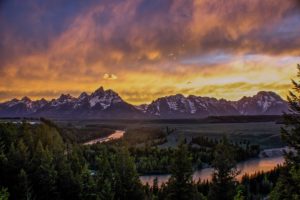
By Davis LaBarre
In the midst of a global pandemic, the one bright spot for many has been spending time outdoors. Increased travel restrictions and cancelled overseas trips have led to packing up the car to visit the beautiful parks our own country has to offer.[1] This summer, Congress passed the Great American Outdoors Act, which became law Aug. 4, 2020.[2] The Act will provide billions of dollars for U.S. national parks to help with repairs and maintenance.[3] However, ensuring that Yellowstone and the other 418 national parks are beautiful for your next family vacation is just the tip of the Glacier Bay National Park iceberg. Linda Bilmes, who served on the U.S. Department of Interior National Parks Advisory Committee, declared that the Act is “the biggest land conservation legislation in a generation.”[4] This post examines two of the larger impacts of the Act: (1) establishing the National Parks and Public Land Legacy Restoration Fund, and (2) endeavoring to fully fund the Land and Water Conservation Fund (“LWCF”).[5]
The Act establishes the National Parks and Public Land Legacy Restoration Fund.[6] The fund will receive 50 percent of all energy development revenues due and payable to the United States from oil, gas, coal, or renewable energy on federal lands and waters for each of the next five fiscal years.[7] Bilmes estimates this will provide up to $9 billion over the next five years, including $6.5 billion earmarked for the 419 national parks.[8] Funding will improve and repair roads, trails, campgrounds, monuments, fire safety, utilities, and visitor infrastructure—which could include COVID-19 tailored updates.[9] Although the number of visitors has increased over the past decade, the parks’ budget has remained unchanged.[10] Accordingly, this new funding will attempt to decrease a $12 billion backlog of maintenance expenses that parks have incurred.[11] Funding helps more than just the typical outdoor enthusiast. Investing in the maintenance of our national parks will likely create more than 110,000 infrastructure jobs.[12] The creation of the Legacy fund will further ensure that the parks’ maintenance backlog does not remain in disarray while also creating jobs, so that Americans can continue to enjoy the parks for years to come.
The Act also fully funds the LWCF providing that all amounts will be made available “without further appropriation or fiscal year limitation” starting perpetually in 2021.[13] The $900 million represents the ceiling that may be authorized, but in most years, Congress has appropriated less than $450 million to the LWCF.[14] This funding guarantees $900 million per year to be paid for by royalty payments from offshore oil and gas drilling that occurs in federal waters.[15] This money will help fund the four main federal land programs (National Parks, National Forests, Fish and Wildlife, and Bureau of Land Management), which support conservation efforts and protect biodiversity.[16] Money will also be given in the form of grants to state and local governments to acquire land for recreation and conservation.[17] Additionally, the LWCF produces economic benefits because the funds have a direct impact on growing the outdoor recreation economy by “increasing recreational access to public lands in every state.”[18] Further, a recent economic study shows that “every $1 million invested in LWCF could support between 16.8 and 30.8 jobs.”[19] Therefore, investing $450 million more than is typically appropriated to the LWCF could result in upwards of 13,000 new jobs.
Although 2020 may have not been a great year thus far, the Great American Outdoors Act highlights one bipartisan effort Americans should be proud of because the Act will help repair and maintain our national parks, support conservation, and create jobs. If you have not had the chance to visit a national park, get outside and appreciate what Wallace Stegner said is “America’s best idea.”[20]
[1] Yellowstone saw an increase in traffic this summer compared to recent years. Nathan Rott, ‘We Had to Get Out’: Despite The Risks, Business is Booming at National Parks, Nat’l Pub. Radio (Aug. 11, 2020, 5:00 PM), https://www.npr.org/2020/08/11/900270344/we-had-to-get-out-despite-the-risks-business-is-booming-at-national-parks.
[2] See Great American Outdoors Act, 54 U.S.C. §§ 200401–200402.
[3] Dan Harsha, The Biggest Land Conservation Legislation in a Generation, Harv. Gazette (July 27, 2020), https://news.harvard.edu/gazette/story/2020/07/the-likely-impact-of-great-american-outdoors-act/.
[4] Id.
[5] Randy Dann & Lucas Satterlee, Congress Passes Great American Outdoors Act, Rocky Mtn. Min. L. Newsl., No. 3, 2020, at 8–9.
[6] Id.
[7] 54 U.S.C. § 200402.
[8] Harsha, supra note 3.
[9] Id.
[10] Id.
[11] Id.
[12] Restoring Parks, Creating Jobs, Cadmus Grp. (Nov. 2018), https://cadmusgroup.com/wp-content/uploads/2019/07/Cadmus-PEW-Jobs-Analysis_07122019.pdf.
[13] 54 U.S.C. § 200402(c).
[14] Id.
[15] Harsha, supra note 3.
[16] Id.
[17] Id.
[18] The Great American Outdoors Act Economic Benefits, Nat’l Governors Ass’n, https://www.nga.org/wp-content/uploads/2020/06/GAO-Act-Economic-Benefits-Factsheet.pdf (last visited Sept. 29, 2020).
[19] Heidi Peltier, Employment Impacts of Conservation Spending, Rsch. Gate(May 2020), https://www.researchgate.net/publication/341554349_Employment_Impacts_of_Conservation_Spending.
[20] See Dann & Satterlee, supra note 5.


